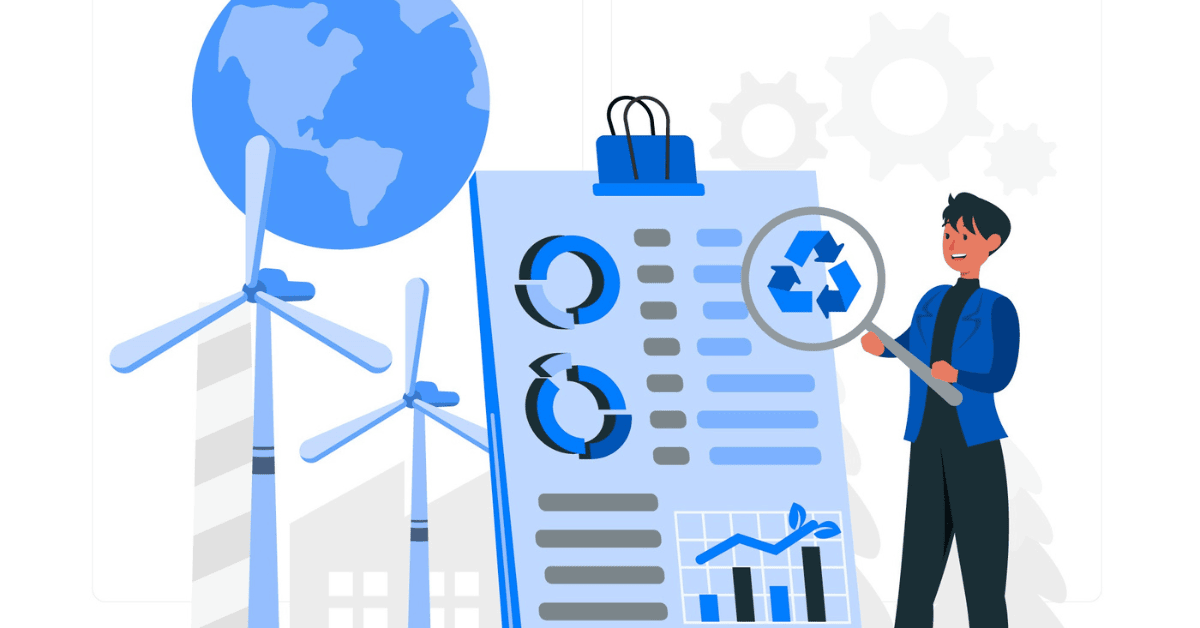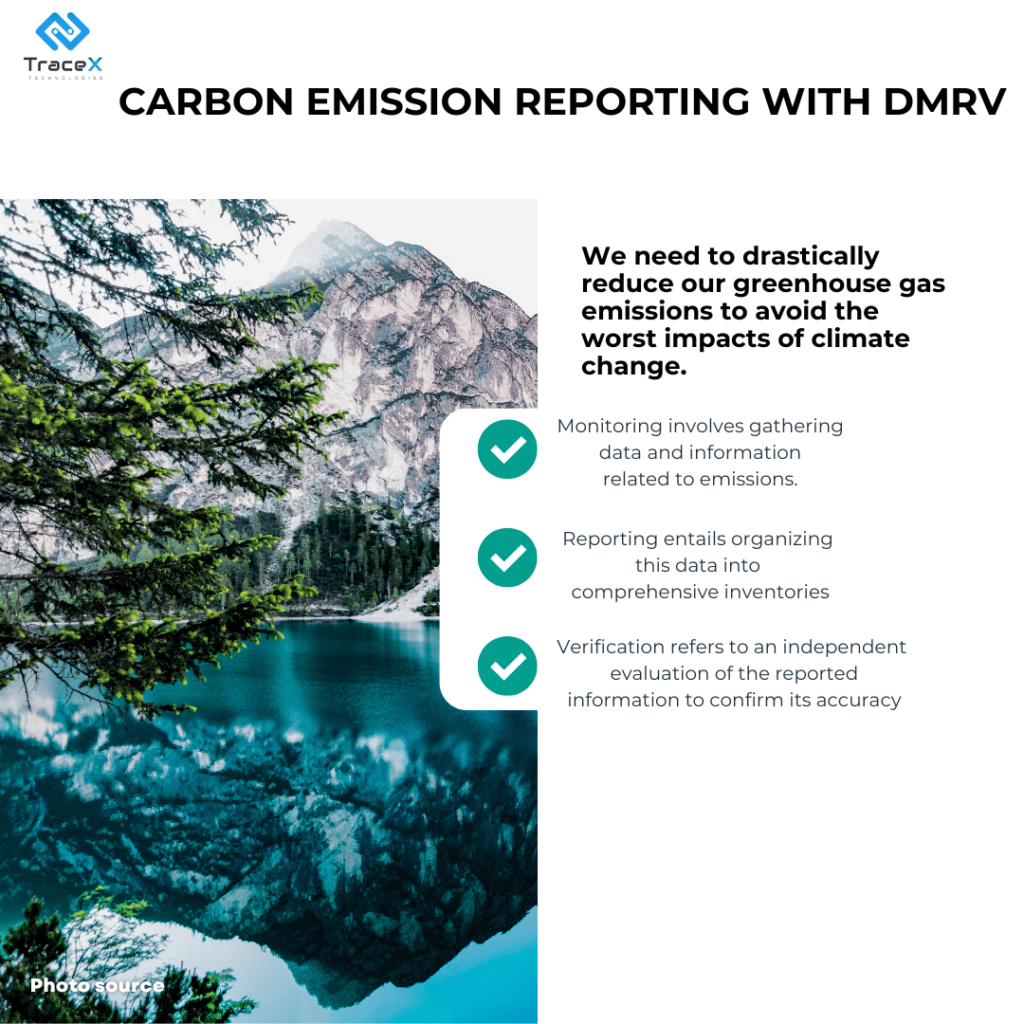Contact: +91 99725 24322 |
Menu
Menu
Quick summary: Discover how Digital MRV platforms, like TraceX, revolutionize carbon emissions reporting with real-time monitoring, advanced analytics, and blockchain transparency. Enhance your sustainability efforts and ensure regulatory compliance effectively.

As sustainability becomes a top priority for businesses across industries, the need for accurate and transparent carbon emissions reporting has never been more crucial. However, traditional methods of Monitoring, Reporting, and Verification (MRV) are often time-consuming, error-prone, and lack the scalability required to meet the growing demand for emissions data. This is where Digital MRV (DMRV) steps in, offering a transformative solution that leverages cutting-edge technologies to streamline the reporting process and drive ethical practices in supply chains.
Businesses today face increasing pressure from stakeholders, regulators, and consumers to report their carbon emissions accurately and transparently. However, the traditional MRV process is fraught with challenges. Digital MRV (DMRV) offers a game-changing solution to the challenges of traditional carbon emissions reporting. By integrating advanced technologies such as remote sensing, data analytics, and blockchain, DMRV streamlines the MRV process, enhancing accuracy, efficiency, and transparency.
Key Takeaways
Digital MRV (Measurement, Reporting, Verification) represents a transformative leap in how organizations track and manage their carbon emissions. Unlike traditional methods, which may rely heavily on manual data entry and subjective reporting, Digital MRV leverages advanced technologies like IoT sensors, blockchain, and machine learning to provide real-time, precise measurements of emissions.
Digital MRV systems facilitate accurate and timely reporting of carbon emissions, ensuring that data is reliable and easily verifiable. Digital monitoring helps automate data collection, reduce human error, and provide detailed insights into emission sources and patterns. For businesses, this means a more streamlined approach to reporting that aligns with regulatory requirements and helps build stakeholder trust.
Digital MRV systems leverage IoT devices and remote sensing technologies to collect real-time data, ensuring that organizations have access to accurate and up-to-date information. This precision is critical for organizations aiming to meet sustainability goals and adhere to regulatory requirements. By automating data collection, digital MRV reduces the risk of human error, leading to more reliable reporting.
Automation is a cornerstone of digital MRV systems. By streamlining the reporting process, organizations can save time and resources that would otherwise be spent on manual data entry and analysis. This efficiency allows staff to focus on strategic initiatives rather than labor-intensive tasks, ultimately enhancing overall organizational performance.
Digital MRV enhances transparency by providing stakeholders with real-time access to emissions data. This transparency fosters trust among consumers, investors, and regulatory bodies, as organizations can demonstrate their commitment to ethical practices through verifiable reporting. By making data available in an accessible format, digital MRV can improve stakeholder engagement and accountability.
Implementing digital MRV can be more cost-effective than traditional methods. By reducing the need for manual data collection and analysis, organizations can optimize resource allocation and minimize waste. The long-term financial benefits of digital MRV make it an economically viable investment, particularly for organizations seeking to enhance their sustainability efforts.
Digital MRV systems are designed to be scalable, allowing organizations to expand their monitoring efforts as needed. As the demand for emissions data grows, digital MRV can accommodate larger datasets and more complex reporting requirements, making it easier for organizations to adapt to changing regulatory landscapes.

The integration of digital MRV into carbon emissions reporting not only enhances efficiency and transparency but also plays a crucial role in promoting ethical practices within organizations.
Digital MRV helps organizations pinpoint areas of concern within their operations, such as high-emission activities or unethical practices. By providing real-time data, organizations can take corrective actions to minimize reputational and financial risks associated with non-compliance.
As regulations around carbon emissions and sustainability continue to evolve, digital MRV ensures that organizations have the necessary documentation and evidence to prove compliance. This proactive approach helps organizations avoid costly penalties and legal battles while positioning them as leaders in sustainability.
Transparent and verifiable emissions reporting builds trust with consumers, investors, and regulatory bodies. By communicating their commitment to ethical practices through digital MRV, organizations can enhance their reputation and foster long-term relationships with stakeholders.
Digital MRV provides the data-driven insights needed to make informed decisions about sustainability investments. By identifying areas for improvement and tracking progress over time, organizations can allocate resources to the most impactful initiatives, ultimately driving positive change.
In the voluntary carbon market, businesses and organizations seek to offset their carbon emissions by purchasing carbon credits. These credits represent a reduction or removal of greenhouse gases equivalent to one metric ton of carbon dioxide. For this market to function effectively, transparent and accurate reporting of carbon emissions is crucial—this is where Digital MRV (Measurement, Reporting, Verification) plays a transformative role.
Conduct a thorough evaluation of existing emissions reporting processes, identifying strengths, weaknesses, and areas for improvement. This assessment will help determine the most suitable DMRV technologies and implementation approach.
Ensure that DMRV systems are designed with data quality and integrity as top priorities. This includes implementing robust data validation and verification protocols, as well as establishing clear data governance policies.
Engage with suppliers, customers, and regulatory bodies to align on DMRV standards, data formats, and reporting requirements. Collaboration helps ensure that DMRV systems are compatible with industry standards and meet the needs of all stakeholders.
Regularly review and update DMRV systems to keep pace with evolving technologies, regulations, and business needs. Continuously monitor the performance of DMRV systems and make adjustments as necessary to ensure optimal efficiency and effectiveness.
The TraceX Digital MRV (Measurement, Reporting, Verification) platform is a cutting-edge solution designed to transform how organizations handle carbon emissions reporting. Leveraging advanced technologies, the TraceX platform offers a comprehensive suite of tools and functionalities that address the complexities of emissions tracking and compliance.
1. Real-Time Monitoring and Data Collection
The platform integrates IoT sensors and other digital technologies to provide real-time monitoring of carbon emissions. This continuous data collection ensures that organizations receive up-to-the-minute information on their carbon footprint, enabling swift responses to any deviations from expected emissions levels.
2. Advanced Analytics and Reporting
At the heart of the TraceX platform is its powerful analytics engine. The platform uses machine learning algorithms to analyze vast amounts of emissions data, identifying patterns, trends, and anomalies. This analysis supports detailed and accurate reporting, helping organizations understand their emissions profile and make informed decisions about reduction strategies.
3. Blockchain-Enhanced Transparency
The platform incorporates blockchain technology to ensure the transparency and integrity of emissions data. By creating an immutable, tamper-proof record of all reported figures, the platform enhances accountability and builds trust with stakeholders. This feature is particularly valuable for demonstrating compliance with regulatory standards and for external audits.
4. Seamless Integration with Existing Systems
The platform is designed to integrate seamlessly with existing Enterprise Resource Planning (ERP) systems and other business software. This integration allows for the efficient flow of data between systems, ensuring that emissions reporting is aligned with other operational and financial data.
5. User-Friendly Interface and Customization
The DMRV software provides a user-friendly interface that simplifies the process of tracking, reporting, and verifying emissions. The platform is customizable to meet the specific needs of different industries and regulatory requirements, ensuring that organizations can tailor the system to fit their unique reporting needs.
6. Robust Security Measures
Data security is a top priority, the platform employs advanced security protocols to protect sensitive emissions data from unauthorized access or breaches. This focus on security ensures that the integrity of the reporting process is maintained and that confidential information is safeguarded.
7. Comprehensive Support and Training
TraceX offers extensive support and training resources to help organizations maximize the benefits of the Digital MRV platform. From initial setup to ongoing maintenance, the TraceX team provides guidance and assistance to ensure that users can effectively utilize the platform and achieve their sustainability goals.
Explore our DMRV Platform
Digital MRV platforms are transforming the landscape of carbon emissions reporting, offering unparalleled accuracy, transparency, and efficiency. By integrating real-time monitoring, advanced analytics, and blockchain technology, these solutions empower organizations to track their carbon footprint with confidence and ease. As regulatory pressures intensify and sustainability goals become increasingly crucial, adopting a robust digital MRV system like TraceX can significantly enhance your emissions reporting processes, ensuring compliance and driving meaningful environmental impact. Embrace the future of carbon management and stay ahead in the quest for sustainability with cutting-edge digital tools.
Digital MRV (Measurement, Reporting, Verification) involves using advanced digital tools and technologies to track, report, and verify carbon emissions. It improves carbon emissions reporting by providing real-time data, enhancing accuracy, and ensuring transparency. These platforms integrate various data sources, including IoT sensors and blockchain technology, to offer a comprehensive view of emissions across the supply chain, facilitating more reliable and efficient reporting processes.
Digital MRV platforms assist organizations in meeting carbon regulations by automating data collection, analysis, and reporting. They ensure compliance with regulatory standards by providing detailed, verifiable emissions data and generating reports that adhere to regulatory requirements. These platforms also offer tools for continuous monitoring and assessment, enabling businesses to proactively address compliance issues and stay aligned with evolving regulations.
TraceX’s Digital MRV platform offers several key benefits, including real-time emissions tracking, enhanced data accuracy, and improved transparency through blockchain technology. The platform provides actionable insights and facilitates seamless reporting, helping organizations streamline their compliance efforts. By integrating various technologies and tools, TraceX ensures comprehensive monitoring and verification of carbon emissions, supporting businesses in achieving their sustainability goals effectively.
